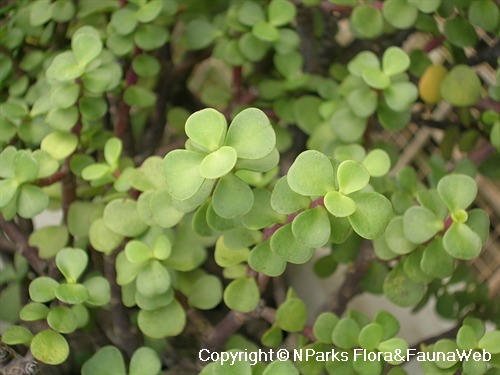
Name
Classifications and Characteristics
| Plant Division | Angiosperms (Flowering Seed Plants) (Dicotyledon) |
|---|---|
| Plant Growth Form | Succulent Plant |
| Mode of Nutrition | Autotrophic |
| Plant Shape | Shrubby |
Biogeography
| Native Distribution | South Africa |
|---|
Description and Ethnobotany
| Growth Form | Succulent shrub growing up to 4-5 m tall in the wild, but up to 2 m tall in cultivation. |
|---|---|
| Foliage | Small, fleshy leaves are triangular with rounded edges (2 cm long). They are smooth, glossy and densely clustered near the stem tips in opposite leaf arrangement. |
| Stems | Woody branches are brown to reddish brown. |
| Habitat | Occurs in the foothills of mountains where there is little rainfall. |
| Etymology | The specific epithet afra means Africa, referring to the origin of the species. |
Landscaping Features
| Landscape Uses | Container Planting, Suitable for Bonsai, Suitable for Rooftops, Interiorscape/ Indoor Plant, General |
|---|---|
| Thematic Landscaping | Rockery / Desert Garden |
Plant Care and Propagation
| Light Preference | Semi-Shade, Full Sun |
|---|---|
| Water Preference | Little Water |
| Plant Growth Rate | Moderate |
| Rootzone Tolerance | Fertile Loamy Soils, Well-Drained Soils, Poor Infertile Soils, Easy to Grow, Drought Tolerant, Shallow Media |
| Maintenance Requirements | Moderate |
| Propagation Method | Seed, Stem Cutting |
Foliar
| Mature Foliage Colour(s) | Green |
|---|---|
| Leaf Area Index (LAI) for Green Plot Ratio | 4.5 (Shrub & Groundcover - Dicot) |
Non - Foliar and Storage
| Stem Type & Modification | Woody |
|---|---|
| Root Type | Underground (Fibrous Root) |
| Specialised Storage Organ(s) | Aboveground |
Floral (Angiosperm)
| Flower & Plant Sexuality | Bisexual Flowers |
| Flower Colour(s) | Pink |
|---|---|
| Flowering Habit | Polycarpic |
Image Repository
Others
| Master ID | 1068 |
|---|---|
| Species ID | 2361 |
| Flora Disclaimer | The information in this website has been compiled from reliable sources, such as reference works on medicinal plants. It is not a substitute for medical advice or treatment and NParks does not purport to provide any medical advice. Readers should always consult his/her physician before using or consuming a plant for medicinal purposes. |



